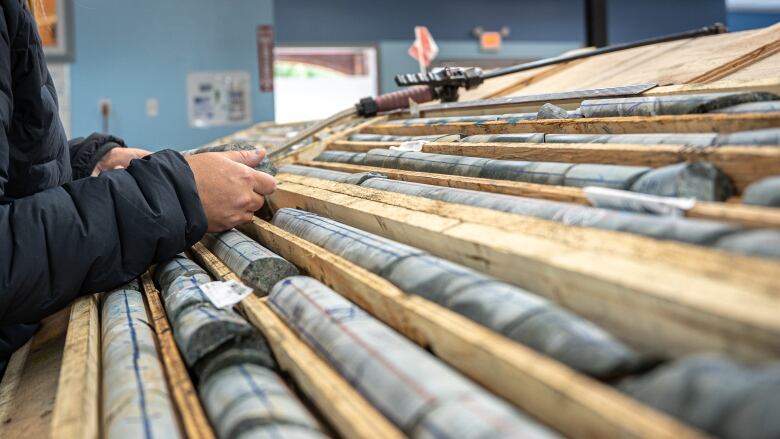B.C. miners push province to aggressively support critical mineral exploration
Industry advocates hoping for big investment in 2024 budget. Critics raise alarms about a free-for-all

Miners in B.C. searching for deposits of minerals deemed critical for low-carbon technologies say they've never been more excited for the sectorbut require extended provincial support to realize their dreams.
Companies say they want to take advantage of the need for critical minerals 31 materials in demand for batteries, electric vehicles, wind turbines and solar panels by having B.C. become an important producer of some of the materialsbut also a role model in the industry for environmental standards and engagement with First Nations.
"It's important that B.C. get involved and move fast. We need to invest in ourselves," said Jessica Van Den Akker, acting president and CEO of the Association for Mineral Exploration B.C. (AME).
The province is currently working on a critical minerals strategy to provide a framework for exploration, extraction, processing and manufacturing that includes Indigenous communities.
"The strategy is collaborative, it's data-driven and fundamentalthat it balances reconciliation, conservation and economic values that B.C. has," said Energy, Mines, and Low Carbon Innovation Minister Josie Osborne.
"We are well underway."

The ministry is spending $6 million over three years on the strategy with the goal of having it available sometime in early 2024.
Available earlier, Osborne said, will be a critical minerals atlas, which will further pinpoint the critical minerals B.C. has and where they may be.
B.C. has known deposits of 16 of the 31 critical mineralsand is the top producer of copper in Canada.
Millions more in funding please
Van Den Akker and others in the industry want far more investment, however.
For the upcoming 2024 budget, they are calling for $50 million for the critical minerals strategy,including $4 million annually to support ongoing critical mineral geoscience work.
AME also wants the province to invest$3 million per year for regional mine offices that would help expedite permits, plus$30 million for an arms-length fund that would invest in exploration companies, especially ones showing potential and appropriate environmental and social governance.
In 2001, Quebec invested $50 million in a similar body called Sidex, which has since bolstered mineral exploration companies with $120 million.
"To reinforce those companies that are doing the right thing," said Van Den Akker about a similar fund for B.C. "It would focus on those companies that are collaborating with the nations."

Earlier this month, some of these proposed initiatives featured in a report from a provincial committee that held public consultations over the next provincial budget due out in February.
As mining minister, Osborne said the sector has her attention. She wants it tocontinue asan economic driver in the province it was worth $7.3 billion in 2020 but with appropriate social and environmental governance.
Some nations in B.C., such as the Tahltan in the northwest of the province, have already shown how productive relationships with explorers and miners can be.
The Tahltan Central Government has said close to 50 per cent of mineral exploration in B.C. takes place in Tahltan territories each year, where there are two active major mines. The nation also has several equity stakes with mineral exploration or mining companies.
The success of the Tahltan and its approach is something the nearby Nisga'a Lisims government hopes to emulate with the rise in demand for critical minerals.
"I'm excited in the fact that there's an opportunity for us as the Nisga'a nation to be more involved to one day maybe be an investor of mines in our area," said Charles Morvan, secretary-treasurer for the Nisga'a Lisims government.
Currently, around 300 people from the nation of 8,000 people work in mining.

'Havoc on the ground'
Critics, meanwhile, say that a push for critical mineral exploration should be tempered by the disruption it can potentially cause and the risk of never finding anything or being able to extract it.
"[Exploration] creates its own buzz, but it doesn't create any long-lasting investment really unless there is something solid coming out of it," said Jamie Kneenwith Mining Watch Canada,
"In the meantime, it sort of creates havoc on the ground."
According to AME, $740 million was spent on mining exploration in 2022, a 10-year high that surpasses the previous record held by the $681 million spent in 2012.
Kneen said as B.C. works to develop its critical mineral strategy and advocates prime it for increased exploration funding, it needs to deliver on previous promises.
One is to formally update B.C.'s Mineral Tenure Act, which currently allows unfettered access to land for prospectors and has led to disputes.
On B.C.'s North Coast, the Gitxaaa First Nation and on Vancouver Island, theEhattesaht First Nation,are waiting oncourtrulings that challengean online registry the province uses to automatically grant mineral rights in its territory.
A June 2022 report from the Office of the Auditor General of British Columbia also said the province had more work to do despite addressing key environmental risks of major mines and enforcement of the mining sector since 2016.












_(720p).jpg)


 OFFICIAL HD MUSIC VIDEO.jpg)
.jpg)



























































































